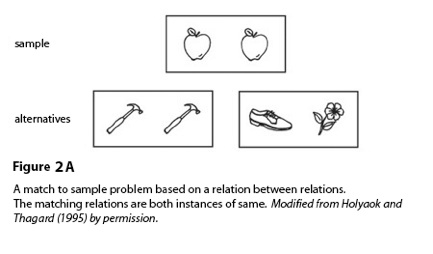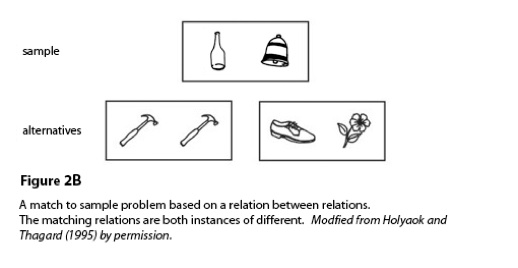Essays

Sameness Versus Difference: From Physical Similarity to Analogy
It is essential to distinguish the relation between objects or properties, from the relation between relations. Most species can match physically alike items, e.g., A and A, B and B (not A and B); but few can match relations between relations, e.g., AA and BB, CD and EF (not AA and CD). Matching relations is the basis of analogies, e.g., AA is to BB as CD is to EF, i.e., sameness is to sameness as difference is to difference. Four-year-old children can match relations, and do adult-level analogies. Chimpanzees cannot either match relations or do analogies, but when given special training, they can do both. Analogies permit humans to escape sensory properties, by introducing concepts that are not based on sensory properties. Analogies also figure in human problem-solving, including the discovery of scientific theories.
Bees are reported to distinguish sameness and difference (Glurfa, Zhang, Jenett, Menzel & Srinivasan, 2001). They learn to match physically alike items, for example, A and A, B and B, C and C (not D and E). Moreover, they show transfer, subsequently matching not only items on which they were trained, but novel items. Equating sameness/difference with physical similarity, however, is a misconception. Sameness/difference is not a relation between objects or properties, and does not concern physical similarity.
Sameness/difference is a relation between relations (Premack, 1976, 1988; Premack & Premack, 1983, 2002). For example, it is the relation between AA and BB, CD and EF, on the one hand; and AA and CD, on the other. AA and BB are both instances of same; the relation between them is “same.” CD and EF are both instances of different; the relation between them, too, is “same.” AA is an instance of same, and CD an instance of different; the relation between them is “different.”
The following figures illustrate the contrasts among match to sample tests based on the following: (i) a relation between objects (physical similarity), (ii) a relation between relations, (iii) a relation between relations where the relations themselves consist of relations.
By David Premack


Reactions to physical similarity appear spontaneously in children at about the 11 th month, for example, they place red blocks in one location, green blocks in another (Sugarman, 1983). Chimpanzees do not spontaneously sort objects, but show an earlier form of matching that appears in children in about their 9 th month (Premack, 1988). Chimpanzees contact physically alike objects consecutively, touching, for example, one red block after another, then one green block after another. Chimpanzees do not alter the positions of the blocks, do not move them into separate locations. They show temporal but not spatial matching.
Though children match physically alike objects precociously, they do not match relations until about four or five years of age. Left to their own resources, chimpanzees never match relations. But they can be trained to do so. One effective means of training is to teach them “words” for both same and different. For example, teach the animal to place a plastic word “same” between two oranges; the word “different” between a banana and an apple. Most chimpanzees will then show transfer, placing both “same” and “different” between novel pairs of like and unlike objects, respectively (Premack, 1976).
Trained in this manner, chimpanzees will then match like relations, (of the kind shown in Figure 2) essentially without further training. They succeed on their first problem (Premack, 1983; Premack & Premack, 1983). Words, however, are not the only way to teach chimpanzees to match like relations. Trial-and-error training on a restricted number of same (AA) and different (CD) cases is also successful, though often requiring hundreds of trials (Premack, 1988).
Although chimpanzees cannot MATCH relations without special training, they can, without special training, pass a looking-time test on same/different. Habituation/dishabitution tests with toys of the kind shown in Figure 4, showed that four, 18-month-old chimpanzees, after playing with AA, then played longer with CD than with BB; conversely, after playing with EF, they then played longer with BB than with CD (Premack & Premack, 2002).



When playing with AA or CD, the animal evidently habituates, not only color, shape, size, etc., but the likeness or unlikeness of the objects in each pair. If the animal habituates likeness while playing with AA, it will then play less with BB, another case of likeness. And it will do the same with the unlike pairs. After playing with EF, and habituating unlikeness, it will then play less with CD, another case of unlikeness.
The untrained chimpanzee passes the one test (looking-time) but fails the other (match-to-sample), because the tests make different demands. The looking-time test requires only that the animal respond to a relation between objects. The match-to-sample test, by contrast, requires that the animal respond to a relation between relations.
The matching of relations varies in difficulty. Relations composed of properties are the easiest to match, those composed of objects are of intermediate difficulty, while those composed of relations are the most difficult.
Relations composed of properties are the easiest to judge because, in most species, innate receptors automatically register the sameness of properties. Rats, for example, recognize that pairs of brightness values--say, 10 brighter than 8, and 5 brighter than 3—are both instances of “brighter than” and therefore the same; whereas pairs of brightness values such as, say, 6 and 4, and 7 and 9, are not the same (Lawrence & DeRivera, 1954). Not only brightness relations-- all properties: sweetness, size, temperature, etc.—are recognized in this manner.
Relations composed of objects are more difficult to judge because there is no innate mechanism for judging the sameness of pairs of objects. One can establish that objects such as A and A are alike by mentally superimposing them. But this procedure cannot be used to establish whether pairs of objects are alike, because neither “same” pairs (AA and BB) nor “different” pairs (CD and EE) are subject to superimposition. In order to match pairs of objects, one must use a different approach, such as “labeling” them “same” or “different,” and then matching the labels (as the chimpanzees were taught to do), or yet another approach.
Matching relations composed of relations, the most difficult case, probably cannot be done by a non-human. Indeed, it is questionable whether children can do it. Perhaps such matching is restricted to human adults.
Analogies
The concept of sameness/difference makes analogies possible; for example, AA is to BB as CD is to EF. A child's ability to use analogies appears at about age three, though his ability is limited and relies heavily on physical similarity. By five, and especially six, children recognize analogies based on the similarity of relations. But not until about 10 years of age can children take a further step and use analogies to solve problems (Holyoak & Thagard, 1995).
Chimpanzees taught the words same/different can do analogies as well as match relations. They can do perceptual analogies, such as “small square is to large square as small circle is to large circle,” as well as functional ones, such as” can opener is to can as key is to padlock” (Gillan, Premack & Woodruff, 1981). The animal's ability to do functional analogies corroborates other evidence indicating that the chimpanzee can attribute goals (Premack & Woodruff, 1978). Turning a key and operating a can opener are not similar actions, nor are the types of objects in the analogy similar. Their equivalence lies in the goal that the two actions share—the goal of opening.
While chimpanzees can do analogies in which the relations are composed of objects, rats, too, may be able to do analogies, provided the relations are composed of properties. For instance, brightness 10 is to brightness 8, as brightness 6 is to brightness 4, may be an analogy the rat can recognize. Probably the rat could do analogies if, say, sweetness were substituted for brightness. This is the interesting question: could the rat do analogies if the dimensions were mixed, for example, brightness 10 is to brightness 8, as sweetness 7 is to sweetness 5?
Analogies contribute significantly to human language. Many key human words are metaphors, and therefore are based on analogies, not sensory properties (Lakoff & Johnson, 1980). Time, a classic example, is a spatial metaphor; while space has normal sensory properties--we can both see and feel it—we can neither see nor feel time. English speakers represent time on the horizontal, placing earlier events to the left of later ones (Mandarin speakers use the vertical, placing earlier events above later ones) (Boroditsky, 2000, 2001 ).
The history of science is replete with theories that have arisen out of analogical thinking. These include evolutionary theory itself, the analogy which Darwin saw between Malthus's account of human population in the face of limited resources, and the struggle for survival engaged in by plants and animals; the likeness between electricity and magnetism which gave rise to Maxwell's theory of electromagnetism; the relation between mind and computer which facilitated Alan Turing's work.
Not only science, but art depends on analogy. The beauty of Shakespeare is elevated by his mastery of the metaphor and of the analogy that lies below it.
Footnote
Experimenters often train an individual to respond, say, left to a pair of alike objects (AA), right to a pair of unalike objects (CD). When the individual transfers to novel objects, they treat this as an example of sameness/difference (e.g., Bovet & Vauclair, 2001). However, this is an error that reduces sameness/difference to physical similarity, and to a relation between objects. The proper test stimuli are not pairs of objects (AA and CD); but pairs of relations: AA and BB, CD and EF; and CD and EE. Correct performance requires that the individual respond left to the first two stimuli, right to the last one.
References
• Boroditsky, L. (2000). Metaphoric structuring: Understanding time through spatial metaphors. Cognition, 75, 1-28.
• Boroditsky, L. (2001). Does language shape thought? Mandarin and English speaker's conception of time. Cognitive Psychology, 43, 1-22.
• Gillan, D. J., Premack, D., & Woodruff, G. (1981). Reasoning in the chimpanzee: I. Analogical reasoning. Journal of Experimental Psychology: Animal Behavioral Processes, 7, 1-17.
• Glurfa, M., Zhang, S., Jenett, A., Menzel, R., & Srininvason, M. (2001). The concepts of “sameness” and “difference” in an insect. Nature, 410, 930-933.
• Holyoak, K. J., & Thagard, P. (1995). Mental Leaps: Analogy in creative thought. Cambridge , MA : MIT Press.
• Lakoff, G., & Johnson, M. (1980). Metaphors we live by. Chicago : University of Chicago Press.
• Lawrence, D. H., & DeRivera, J. (1954). Evidence for relational transposition. Journal of Comparative and Physiological Psychology, 47, 465-471.
• Premack, D. (1976). Intelligence in ape and man. Hillsdale , NJ : Erlbaum Press.
• Premack, D. (1983). The codes of man and beasts. Behavioral and Brain Sciences, 6, 125-167.
• Premack, D. (1988). Minds with and without language. In L. Weiskrantz, (Ed.), Thought without language (pp. 46-65). Oxford : Clarendon Press.
• Premack, D.,& Premack, A. J. (1983). The mind of an ape. New York : W.W. Norton.
• Premack, D., & Premack, A. (2002). Original intelligence: Unlocking the mystery of who we are. New York : McGraw-Hill.
• Premack, D,,& Woodruff, G. (1978). Does the chimpanzee have a theory of mind? Behavioral and Brain Sciences, 4, 515-526.
• Sugarman, S. (1983). Children's early thought: Developments in classification. New York : Cambridge University Press.
